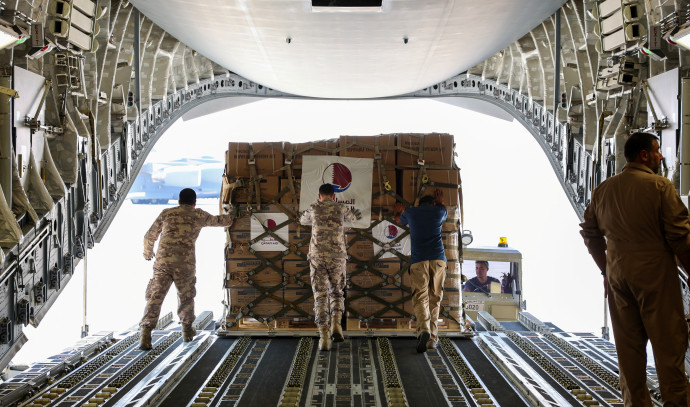Indian Defense
IAF Self-Reliant For 95% of Its Daily Requirements, Saved 160 Crores: Air Marshal Vibhas Pande

A MiG-29 firing Exocet missile during Malabar exercise
Air Marshal Pande highlighted the IAF’s strides in achieving self-reliance, completion of the MiG-29 upgrade, and outlined plans for indigenous production Air Marshal Vibhas Pande spoke about the advancements made by the IAF in achieving self-reliance, concluding the MiG-29 upgrade, and laying out strategies for indigenous production
Air Marshal Vibhas Pande, Chief of the Indian Air Force’s Maintenance Command, recently emphasised the strides made by the IAF in maintaining and upgrading its fleet through indigenous efforts, achieving self-reliance, or ‘Atmanirbharta,’ amidst evolving global dynamics.
Indigenous Initiatives And Dependency
The Air Marshal highlighted, “For the Sukhoi 30, our dependency is on HAL. For the MiG-29, we have done a lot of indigenization. The Russia-Ukraine conflict had no impact on the MiG-29 operation. With the support of HAL, we have been able to sustain the fleet very well.”
Successful Completion of MiG-29-UPG Program
Despite incomplete Russian support, Pande underlined the successful completion of the MiG-29-UPG or upgrade program. “The upgrade program of the MiG-29 has been completed without complete supply by the Russian side,” Pande stated. Addressing the financial gains from indigenous initiatives, Pande mentioned, “We have created 3000 production lines for the supply of LRUs, thus saving 160 crores.”
Progress Towards Self-Reliance And Future Goals
The Air Marshal underlined the IAF’s achievement of 95-97 percent self-reliance in daily requirements and stressed the need to further focus on indigenization to fulfil the vision of an ‘Aatmanirbhar Bharat’ outlined by the Prime Minister. He highlighted challenges in developing technology for Automatic Replenishment Spares (ARS) or Line Replaceable Units (LRUs), highlighting the complexity involved in critical calculations for such technology.
Thrust Towards Indigenisation And Collaborative Efforts
“We will have to give a little more thrust to our indigenisation and work harder to achieve our PM’s vision of Aatmanirbhar Bharat. Right now, the plan is to manufacture the spare parts required by us in our country as soon as possible,” Pande added, mentioning the renewed ‘impetus’ provided by BRD and HAL during the conflict for the development of necessary new spares. Additionally Pande said this LRUs or ARS are ‘Made in India’ and not ‘Make in India’.
Future Acquisitions And Self-Sufficiency
Discussing future acquisitions, Pande expressed the IAF’s requirement for the TEJAS MK-1A variant, scheduled for delivery from 2024. “The Air Force is in continuous dialogue with HAL as we aim for more planes. We strive for expedited production and delivery to enhance our operational capabilities,” he stated.
Underlining the journey towards self-sufficiency, Pande emphasised the collaborative indigenisation efforts with MSMEs since the dissolution of the USSR in the 90s. He added, “Today, 97 percent of our Automatic Replacement System’s spare parts used daily are ‘Made in India.’ We no longer rely on any foreign country for these.”
Indian Defense
INS Arihant’s Nuke-Capable K-4 Submarine-Launched Ballistic Missile ‘Ready To Roll’

The solid-fuelled K-4 missile is being developed by DRDO to arm the country’s nuclear-powered submarines in the shape of INS Arihant and its under-development sister vessels. INS Arihant, which became fully operational in November 2018 to complete India’s nuclear triad, is currently armed with the much shorter K-15 missiles with a 750 km range.
“The K-4 is now virtually ready for its serial production to kick-off. The two tests have demonstrated its capability to emerge straight from underwater and undertake its parabolic trajectory,” said a source.

India has the land-based Agni missiles, with the over 5,000-km Agni-V inter-continental ballistic missile now in the process of being inducted, and fighter jets jury-rigged to deliver nuclear weapons. But INS Arihant gives the country’s deterrence posture much more credibility because nuclear-powered submarines armed with nuclear-tipped missiles are considered the most secure, survivable and potent platforms for retaliatory strikes.
Once the K-4 missiles are inducted, they will help India narrow the gap with countries like the US, Russia and China, which have over 5,000-km range SLBMs. The K-4 missiles are to be followed by the K-5 and K-6 missiles in the 5,000-6,000 km range class.
The 6,000-ton INS Arihant, which is propelled by an 83 MW pressurised light-water reactor at its core, in turn, is to be followed by INS Arighat, which was launched in 2017. The next generation of nuclear submarines, currently called S-4 and S-4*, will be much larger in size.
Indian Defense
After Upgradation, Sukhoi Su-30MKI Indigenisation To Reach 78%

India has received clearance to upgrade 84 Sukhoi Su-30MKI fighter jets, which will result in 78% indigenization after the upgrade
In a significant step towards bolstering its military might with indigenously developed technology, India is poised to witness its Russian-origin Sukhoi Su-30MKI fighter jets evolve into a domestic platform. Speaking at a recent lecture.
The upgrade program is being led by Hindustan Aeronautics Limited (HAL) in partnership with the Indian Air Force and other partners. The upgrade is expected to cost US$7.5 billion.
This initiative is a part of a larger effort by the Indian Air Force to modernize its ageing fleet. Air Chief Marshal Chaudhari asserted the critical role of an offensive air force as demonstrated in current global conflicts and emphasized India’s move towards an indigenized arsenal. To this end, the IAF has been proactive, from upgrading its Mirage 2000 to enhancing its MiG-29 fleet.
In summary, the IAF’s commitment to updating their combat forces with the latest technology, including shifting to fifth-generation fighter jets, ensures operational preparedness and a strong deterrence capability. The gradual indigenization of its air fleet marks a pivotal shift in India’s defence landscape, reducing dependency on foreign imports and fostering technological sovereignty.
Indian Defense
Akash Weapon System Exports For The Armenian Armed Forces Gathers Pace

According to unconfirmed reports, Armenia is a top contender for an export order for Akash SAM system manufactured by Bharat Dynamics Limited (BDL).
The Akash export version will also be slightly different from the one inducted by the armed forces. The 100-km range air-to-air Astra missiles, now entering production after successful trials from Sukhoi-30MKI fighters, also have “good export potential”, said sources.
Akash is a “tried, tested and successfully inducted systems”. Indian armed forces have ordered Akash systems worth Rs 24,000 crore over the years, and MoD inked a contract in Mar 2023 of over Rs 9,100 crores for improved Akash Weapon System
BDL is a government enterprise under the Ministry of Defence that was established in 1970. BDL manufactures surface-to-air missiles and delivers them to the Indian Army. BDL also offers its products for export.
Akash Weapon System
The AWS is a Short Range Surface to Air Missile (SRSAM) Air Defence System, indigenously designed and developed by Defence Research and Development Organisation (DRDO). In order to meet aerial threats, two additional Regiments of AWS with Upgradation are being procured for Indian Army for the Northern borders. Improved AWS has Seeker Technology, Reduced Foot Print, 360° Engagement Capability and improved environmental parameters.
The project will give a boost to the Indian missile manufacturing industry in particular and the indigenous defence manufacturing ecosystem as a whole. The project has overall indigenous content of 82% which will be increased to 93% by 2026-27.
The induction of the improved AWS into the Indian Army will increase India’s self-reliance in Short Range Missile capability. This project will play a role in boosting the overall economy by avoiding outgo of precious foreign exchange to other countries, increasing employment avenues in India and encouraging Indian MSMEs through components manufacturing. Around 60% of the project cost will be awarded to the private industry, including MSMEs, in maintaining the supply chain of the weapon system, thereby creating large scale of direct and indirect employment.
-

 Solar Energy3 years ago
Solar Energy3 years agoDLR testing the use of molten salt in a solar power plant in Portugal
-

 Camera3 years ago
Camera3 years agoCharles ‘Chuck’ Geschke, co-founder of Adobe and inventor of the PDF, dies at 81
-
world news8 months ago
Gulf, France aid Gaza, Russia evacuates citizens
-
world news3 months ago
Jewish diaspora expresses concern as Iranian drones launch toward Israel
-

 Camera3 years ago
Camera3 years ago80,000MP panoramas: EarthCam announces world’s highest-resolution robotic webcam
-

 TOP SCEINCE3 months ago
TOP SCEINCE3 months agoCan animals count?
-

 Solar Energy8 months ago
Solar Energy8 months agoGlencore eyes options on battery recycling project
-

 Camera8 months ago
Camera8 months agoDJI Air 3 vs. Mini 4 Pro: which compact drone is best?



